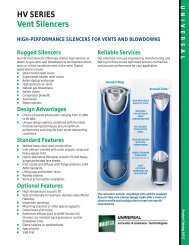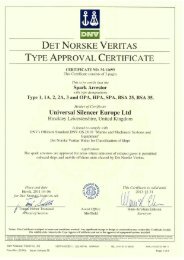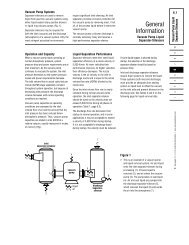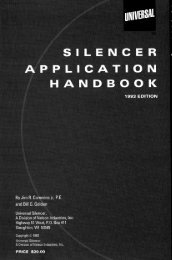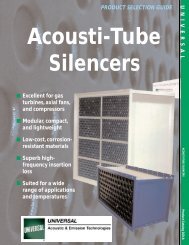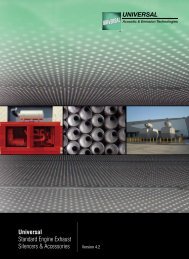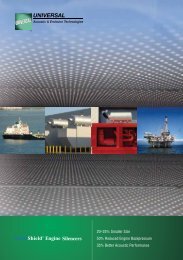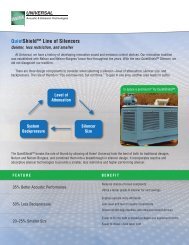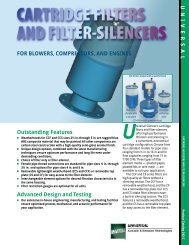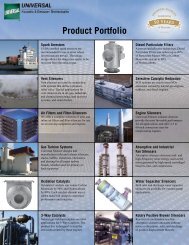Combined Cycle Systems - Universal: Acoustic Silencers
Combined Cycle Systems - Universal: Acoustic Silencers
Combined Cycle Systems - Universal: Acoustic Silencers
Create successful ePaper yourself
Turn your PDF publications into a flip-book with our unique Google optimized e-Paper software.
<strong>Combined</strong> <strong>Cycle</strong> <strong>Systems</strong> For the Utility IndustryTABLE OF CONTENTSIntroduction 3Basic Power Plant 4Conventional Steam Power Plants 4Simple <strong>Cycle</strong> Peaking Plants 5<strong>Combined</strong> <strong>Cycle</strong> Power Plant s 5Gas Turbines Basics 7History 7Applications of Gas Turbines 9Brayton <strong>Cycle</strong> 10Performance Characteristics 11Heat Recovery Steam Generator 12Steam Turbine 12Generators 13Controls 13Ancillary Equipment 14Plant Operation 15Plant Arrangement 15Installation 15Future Load Expansion 15Author’s Experience 16Background 16Diverter Damper Description 18Conclusions 22References 23
INTRODUCTION:Power plants can be defined by functional type (e.g. base load, peak load, or combinedcycle). Each has advantages and disadvantages.Base load power plants have the lowest operating cost and generate power most in anygiven year. There are several different types of base load power plants. The resourcesavailable typically determine the type of base load plant used to generate power. Coaland nuclear power plants are the primary types of base load power plants used in theMid-West United States.There are four types of base load power plants:ooooHigh efficient combined cycle plants fueled by natural gasNuclear Power PlantsConventional steam power plants fueled primarily by coalHydropower plantsPeak load power plants are simple cycle gas turbines that have the highest operating costbut are the cheapest to build. They are operated infrequently and are used to meet peakelectricity demands in period of high use and are primarily fueled with natural gas or oil.The high efficient combined cycle power plant will be the focus of this project.Gas turbines have increased in capacity over the last 25 to 45 years. Gas Turbines withrated outputs of 40 to over 350 MW that have increased specific power has led to theparallel development of highly efficient economical combined cycle power generationsystems.Each combine cycle (CCGT) power-generating system consists of a gas turbine, HeatRecovery Steam Generators (HRSGs), generators, controls, and a steam turbine.<strong>Combined</strong> cycle systems typically are an optimized system of high technology powergenerating equipment, software, and services that are integrated into the utilities ancillaryequipment to create an economical and stable power generating facility.<strong>Combined</strong> cycle systems encompass a large range of capabilities for both 50 and 60 Hzoperation. <strong>Combined</strong> cycle systems are versatile allowing for many differentconfigurations to satisfy the requirements of individual applications.There are two major categories of combined cycle systems:1 Oil or natural gas fired systems for power generation.2 <strong>Combined</strong> cycle cogeneration systems and coal or oil fired integratedgasification combined cycle (IGGG) power generation systems.2
There are many configurations for combined cycle systems. A significant portion of thesystems contain an electrically controlled diverter damper, seal air fans, positionindicators, and some type of control systems that integrates these components. It is theintent of this project to describe one such system that the author helped design, install,verify, and commission. The duration of the project, located in the Mid Atlantic regionof the United States, was over 24 months in duration. The construction phase was in twoparts. The first phase consisted of installation of three 100 MW rated turbines, ancillaryequipment and commissioning of simple cycle operation while the HRSGs were beingcompleted. This was completed in a relatively short period of approximately twelvemonths. The commissioning of the combined cycle systems is happening as this paper isbeing prepared (May 2002).BASIC POWER PLANTS:There are many types of power generating power plants. The basic features of the threemost common types are described below. The steam plant, the simple cycle peakingunits and the combined cycle power plants basic features are described below. After thebasic features are described, much time will be spent on the combined cycle plant and thecomponents that make up such a power generation facility.Conventional Steam Power plants:The conventional power plant that has been the basis for electric power generation formany years burns fuel to heat a boiler to produce steam. The steam is then used to turn asteam turbine that drives an electric generator. The steam is then condensed back to water(this requires the use of cooling water) and then is reheated. Conventional steam powerplants can use a variety of fuels, basically anything that burns can be used. Typical fuelsare coal, gas, oil, or biomass.Features of conventional steam power plants are:They are about 34% efficient in converting fuel to electricity.Their heat rate is about 10,000 Btu (British Thermal Units) of fuel “heat”burned per kilowatt-hour (kWh).Conventional steam power plants are slow to start or to change output whileoperating.The low operating cost of steam power plants is a result of the inexpensive fuelused.Simple <strong>Cycle</strong> Peaking Units:With coal costs of $1.35/MMBtu, the fuel cost of producing electricity isabout 1.35 cents/kWh New .3
Simple-cycle power generation plants are simply the basic gas turbine mounted in a noisereducing enclosure. Typically they are aeroderivative type gas turbines similar to jetaircraft engines. As a comparison, an engine of a Boeing 737 is equivalent to a 25 to 30MW simple cycle power plant.Simple cycle power plants typically use natural gas as fuel with kerosene or distillate oilas a back up. They are used to meet the highest (peak) electricity demands, for examplevery hot summer afternoons.Basic features of a simple cycle power plant are listed below:Simple cycle power plants have a heat rate of 9,900 to 12,000 Btu/kWh (28 to35% efficient).The start up time to full load is approximately 10- 20 minutes.Low operation and maintenance (O & M) costs. This is because they have fewmoving parts or staff requirements and the moving parts move in a radial motionvs. the piston type motion of other internal combustion engines.They are expensive to operate. The high fuel cost (relative to base load powerplants) makes for expensive peak power.Assuming natural gas costs of $3.50 MMBtu, the fuel cost of producingelectricity is 4 cents/kWh New .<strong>Combined</strong> <strong>Cycle</strong> Power Plant:A combined cycle gas turbine power plant is essentially an electrical power plant inwhich a gas turbine and a steam turbine are used in combination to achieve greaterefficiency than would be possible independently. The gas turbine drives an electricalgenerator while the gas turbine exhaust is used to produce steam in a heat exchanger(called a Heat Recovery Steam Generator, HRSG) to supply a steam turbine whoseoutput provides the means to generate more electricity. If the steam is used for heat (e.g.heating buildings) then the plant would be referred to as a cogeneration plantFigure 1 is simple representation of a CCGT system. It demonstrates the fact that aCCGT system is two heat engines in series. The upper engine is the gas turbine. The gasturbine exhaust is the input to the lower engine (a steam turbine). The steam turbineexhausts heat via a steam condenser to the atmosphere.4
Figure 1: Schematic of <strong>Combined</strong> <strong>Cycle</strong> (CCGT) power plant. Overall efficiency(η CC ) is a combination of the efficiency of the Brayton (η B ) gas turbine cycle and theRankine steam turbine cycle (η R ). Total combined cycle efficiency is η CC =η B + η R –(η B * η R ) Chase .The combine cycle efficiency (η CC ) can be derived by the equation 1 Langston .η CC = η B + η R - (η B * η R ) (1)Equation (1) states that the sum of the individual efficiencies minus the product of theindividual efficiencies equals the combine cycle efficiency. This simple equation givessignificant insight to why combine cycle systems are successful.For example, suppose the gas turbines efficiency η B is 40% (a reasonable value for atoady’s gas turbines) and that the steam turbine efficiency η R is 30% (a reasonable valuefor Rankine <strong>Cycle</strong> steam turbine).Utilizing equation (1) would lead to the following conclusion.η CC = 0.4 + 0.3 – (0.4 * 0.3)η CC = 0.585
η CC = 58%The combined cycle efficiency of 58% is much greater than either the gas turbine or thesteam turbines efficiencies separately. The 58% value is slightly misleading in thatsystem losses were ignored. Efficiency values in the 60% range have been recorded forCCGT systems in the past few years Chase .CCGT power plants may come in many different configurations. Some companies chooseto treat the gas turbine exhaust bypass stack as a commodity, others choose to incorporatea diverter damper into the turbine exhaust gas path. The diverter damper allows for therapid configuration of the power plant as a combined cycle or simple cycle system. Theinitial cost of the diverter damper is much higher than the cost of treating the gas turbineexhaust stack as a commodity however, the diverter damper allows for the gas turbines tobe operated in simple cycle when HRSG or steam turbine repair or maintenance isrequired.Some of the basic features of the combine cycle power plant are listed below:<strong>Combined</strong> cycle plants use the hot exhaust gas from gas turbines to make steam,which drives a steam turbine which drives a generator to produce electricity.Power output of the steam turbine is typically 1/3 of the total output of the totalpower output of the combine cycle power plant. It is this “extra” electricityproduced from the same amount of turbine energy (without additional fuelconsumption) that makes a combined cycle plant much more efficient than asimple cycle gas turbine peaking plant.Overall efficiency of converting fuel to electricity is greater than a peaking plant44 to 52% (Heat Rate of 6,600 to 7,700 BTU/kWh).The steam portion of combined cycle plants takes approximately 1.5 to 3 hours toheat up. This is much slower than a true peaking plant that can be at load in about10 – 20 minutes.The combine cycle system cost is obviously a more expensive capital expenditurethan a peaking plant (simple cycle plant).However, a combine cycle plant has a high efficiency in converting fuel toelectricity which makes it possible for relatively high price fuels like natural gasto be competitive for intermediate or base loads.For natural gas costing $3.50/MMBtu, the fuel costs of producingelectricity is about 2.3 cents/kWH, which is less, expensive than some coalfired plants NEW .6
Described below are the features of major components of a CCGT power generatingplant that are required for safe efficient reliable combined-cycle systems.GAS TURBINE BASICS:History:A turbine is any kind of spinning device that uses the action of a fluid to produce work.Air, wind, water, steam, and helium are typical fluids used by a turbine to produce work.Windmills and hydroelectric dams have used turbine action for decades to turn the coreof an electrical generator to produce power for residential and industrial applications.Simpler turbines are much older with the first known appearance dating to the time ofancient Greece Langston .Gas Turbines are relatively new in the history of energy conversion. The first practicalgas turbine used to generate electricity ran at Neuchatel, Switzerland in 1939, and wasdeveloped by the Brown Boveri Company. The first gas turbine powered airplane flightalso took place in 1939 in Germany, using the gas turbine developed by Hans P. vonOhain Langston .The simultaneous development of the gas turbine for electric power generation field andthe aviation field led to the gas turbine being known by several different names. Theelectric utility industry generally refers to the gas turbine as a gas turbine, combustionturbine, a turboshaft engine, and sometimes a gas turbine engine. The aviation industrygenerally to the gas turbine as a jet engine. Various other names will be used dependingon the application or engine configuration such as jet turbine engine, turbojet, turbofan,fan-jet, and turboprop or propjet (when used to drive a propeller).Many people assume that gas turbines use gas as its fuel. However, a gas turbine uses acompressor to suck in and compress gas (usually air), a combustor to add fuel to heat thecompressed air, and a turbine to extract power from the hot air flow. Gas Turbines areinternal combustion (IC) engines that implement a continuous combustion process. Anintermittent combustion process characterizes IC engines used in automotive or dieselapplications.Figure 2 is the schematic of the two basic types of Gas Turbines. The schematicrepresented by (a) is the aircraft engine and the schematic (b) represents a land-based gasturbine typically used for power generation in the utility industry. The compressor,combustor, and turbine part of figure 2 is commonly called the gas generator Langston .7
Figure 2: Schematic for (a) an aircraft jet engine and (b) for a land based gasturbine Langston .Applications of Gas Turbines:The aircraft gas turbine output is used to turn the compressor (which may have anassociated fan or propeller). The hot air flow of the turbine is then accelerated through anexhaust nozzle into the atmosphere to provide thrust (propulsion power). Aircraft enginesoutput can range from about 100 pounds of thrust to as high as 100,000 pounds of thrustand range in weight from 30 pounds to 20,000 pounds.In non-aviation gas turbines, part of the turbine power is used to drive the compressor.The remainder, the ‘useful power’ is used as an output shaft power to turn an energyconversion device (figure 2b) such as an electrical generator or a ship’s propeller.Land based gas turbines range in power output from 0.05MW (Megawatts) to greaterthan 550 MW. The lighter weight units derived from aircraft jet engines are know asbasic aeroderivative type engines. Aeroderivative engines traditionally are utilized todrive compressors at natural gas pipelines pumping stations, power ships, and to providepeaking power for electric utility applications. Peaking power supplements a utility’snormal power output during high demand periods (summer demand on hot days).However, they are increasing being used for base load electrical generation and combinecycle operation Langston . Larger heavier weight machines designed for land applicationsserving the utility industry are called industrial or frame engines.The gas turbine machine has five principal advantages listed below:8
1 The gas turbine produces a large amount of useful power in a relatively small sizeand weight.2 Maintenance cost is relatively low and its mechanical life is long when comparedto a piston driven engine. All the gas turbine major components that move do soin rotation (no reciprocating motion as in a piston engine). However, repair costsare typically much higher for a gas turbine than for a reciprocating engine.3 The start up time for a gas turbine to full load is measured in minutes vs. hours fora steam turbine plant.4 Gas Turbines can operate utilizing a wide variety of fuels. Natural gas is typicallyused for land based machines while a lighter distillate is used for aircraftapplications.5 Atmospheric air is typically the working fluid for gas turbines and generallyrequires no coolant for basic power generation Langston .Low efficiency (high fuel usage) was a major disadvantage of gas turbines in the pastwhen compared to other IC engines and steam turbine power plants. Continuousengineering development work over the past fifty years has pushed the thermal efficiencyfor 18% in 1939 to about 43 % today for simple cycle operation and 60 % for combinedcycle operation Chase . These thermal efficiency values are significantly higher than forother prime providers of electrical power such as steam power plants.The Brayton <strong>Cycle</strong>:Gas turbine cycles describe what happens to air as it passes into, through, and out of thegas turbine. The cycle describes the relationship between the volume (V) of air in thesystem and the pressure (P) the air is under. The Brayton cycle developed in 1876,shown in graphic form as Figure 3 is a pressure-volume diagram that represents theproperties of a fixed amount of air passing through a gas turbine in operation. Figure 4shows the same Brayton cycle point on an engine schematic.9
Figure 3: Brayton <strong>Cycle</strong> pressure-volume diagram for a unit mass of working fluid(e.g. air), showing work (W) and heat (Q) inputs and outputs Langston .Air is compressed from point 1 to point 2 increasing the gas pressure as the volume of thespace containing the air is reduced. The air, at constant pressure, is heated from point 2to point 3. This is accomplished by injecting fuel into the combustor and continuouslyigniting the fuel. Expanding air from point 3 to point 4 reduces the gas pressure andtemperature and increases the volume of the gas. In the engine schematic of figure 4, thisrepresents the flow through the turbine to point 3’ and then flow from the power turbineto point 4 to turn a shaft. The useful work in figure 3 is indicated by the curve from point3’ to point 4. The useful work is the energy available to cause output shaft power for aland based gas turbine (used to turn a generator for the utility energy). Exhausting thegas turbine exhaust gas to atmosphere where the volume of air cools resulting in lessvolume completes the Brayton cycle. Heat from the exhaust gas is absorbed into theatmosphere Langston .Performance Characteristics:Figure 4: Gas Turbine schematic showing relative pointsof the Brayton <strong>Cycle</strong> Langston .Specific power is the key performance characteristics of a gas turbine engine thatinfluences combined-cycle performance. Specific power is the power produced by the gasturbine per unit of airflow (kW output per lb/sec of compressor airflow). High specificpower provides the lowest simple-cycle cost while ensuring the highest combined-cycleoperation efficiency.<strong>Combined</strong>-cycle thermal efficiency increases as gas turbine specific power increases. Thegas turbine firing temperature is the primary determinant of specific power.Development of high temperature/high strength materials, corrosion resistant coatings,and improved cooling technology have led to increases in gas turbine firing temperatures.This increase in firing temperature is the primary development that has led to increases inCCGT thermal efficiencies. The improvements in combined-cycle thermal efficienciesand the commercial development of combined-cycle power plants have proceeded inparallel with advances in gas turbine technologies Chase .10
Typical gas turbine exhaust gas temperatures of 1000-1100 0 F are well suited to efficientcombine-cycle operation. The exhaust gas temperature enables the heat transfer fromexhaust gas to steam cycle to occur with minimal temperature difference. This smalldifference ensures maximum in thermodynamic availability while operating with thehighest steam cycle efficiency.Gas turbine materials, coatings, and cooling systems enable reliable high firingtemperatures. This achieves high gas turbine specific power and high efficiency ofcombined-cycle operation.HEAT RECOVERY STEAM GENERATOR:HRSGs are typically unfired and modular in design with finned-tube heat transfersurfaces and natural or forced-circulation evaporators. Figure 5 is an illustration of aNatural-circulation HRSG with modular construction.Figure 5: Natural Circulation HRSG modular construction Chase .<strong>Combined</strong>-cycle power plants typically have many common features and several uniquefeatures that are site specific. A common arrangement is to have each gas turbine exhaustto a single HRSG. There are systems designed that two gas turbines would exhaust into asingle HRSG. All HRSGs would exhaust into a common header that feeds the steamturbine. HRSG design features are:Flexible tube support system to enable fast startup and load following capability.Low gas side pressure drop for optimum gas turbine performance.Large modular factory tested modules that can be shipped to provide reduceinstallation time and competitive construction cost Chase .STEAM TURBINE:11
Steam turbines for combined-cycle power plants generally are of two styles. Steamturbines with different exhaust annulus areas are available to permit optimization to meetspecific condenser cooling conditions. Steam turbines with large annulus areas are moreexpensive, but provide increased capability and may be the most economical selection forapplications with low steam turbine exhaust pressures. Steam turbines with smallexhaust annulus area provide comparable or higher capability and low cost and are themore economical choice when steam turbine exhaust pressures are high.<strong>Combined</strong> cycle steam turbines have features that include but are not limited to:Modules assembled where they can be shipped and field assembled with a lowprofile installation, reducing installation time and cost.Borescopic inspection access ports where the upper turbine casing does not haveto be removed during inspection.Main cold and hot reheat pipes as well as the main steam pipes connect to thelower half of the shell. This allows removal of the upper half shell formaintenance.GENERATORS:Air cooled generators are standard for small combined cycle systems utilizing gasturbines rated at approximately 100 MW and below. They may be open ventilated orcompletely enclosed water-to-air cooled. Hydrogen-cooled generators are standard forlarger systems. Hydrogen cooled generators can be cooled by plant-cooling water or byambient air with water-to air heat exchangers Chase .CONTROLS:<strong>Combined</strong>-cycle power plants typically have a distributed digital control (DCS) withredundant data transmission paths. Station operator controls provide an interactive colorgraphic displays of the overall combine-cycle system to enable the operator to operate theplant.While the control systems for each installation may be tailored to the particular plant,they will all have the same principal objectives of simple operation, easy starting,automated operation and excellent load following capability. Each of the maincomponents of the combine-cycle system will have individual control panels andinterfaces that relay information to and from the plant operator through data ports to theoperator console. Operator consoles generally have a detailed graphic display with a highlevel of detail that enables convenient and informative interaction with the plant asrequired.Most control systems operate with a minimum of control loops. This in conjunction withwell-established, automated operation of system components allows effective automation12
of the complete power plant. This minimizes the number of control operators. Mostsystems operate with only one control operator and one roving operator.Typical multi-shaft control systems are configured to enable automated startup andoperation after remote manual starting of plant auxiliaries, remote manual operation ofeach major component, or operation of the gas turbine-generator units from local-controlcompartments. Maximum availability is ensured because the plant can be operatedremotely with no additional control room operators. Equipment protection is typicallyprovided within the control unit thereby ensuring that normal protection is maintainedduring all modes of operation, including local or remote manual operation.Typical single shaft control systems are microprocessor-based controllers that coordinatethe operation of each of the components in each integrated combined-cycle unit andcommunicate with the plant control. Because of the simple steam cycle, the tandemcoupling of the gas and steam turbines to a single generator, and the elimination of theHRSG exhaust-gas, bypass system, the single-shaft control system is simple. Starting,operation, and shutdown of individual components are automatic. Single-shaft unitstypically controlled by a local control unit that is coupled to the central control operator’sconsole by a data port. One control room operator and a one local operator can operateone or more single shaft combine cycle units Chase .ANCILLARY EQUIPMENT:The combined-cycle system can be equipped with several types of ancillary equipment.One such piece of ancillary equipment is a diverter damper. A diverter damper is adevice that directs the gas turbine exhaust flow to either the HRSG for combine-cycleoperation or to a bypass stack for simple cycle operation. The installation of a newcombined cycle power plant is a major operation that is measured in months if not years.Typically, the utility will chose to complete the project in phases where phase 1 is toinstall the turbine(s) in simple cycle mode with the appropriate ancillary equipment(which may or may not include a diverter damper). This allows the utility to sell thepower generated by the gas turbines much sooner than if the entire project had to becompleted to sell power. Phase 2 usually entails bringing the HRSG(s) and the steamturbine online.Some utilities choose to treat the gas turbine exhaust bypass stack as a commodity, otherschoose to incorporate a diverter damper into the turbine exhaust gas path. The diverterdamper allows for the rapid configuration of the power plant as a combined cycle orsimple cycle system. The initial cost of the diverter damper is much higher than the costof treating the gas turbine exhaust stack as a commodity however, the diverter damperallows for the gas turbines to be operated in simple cycle when HRSG or steam turbinerepair or maintenance is required.Two basic types of diverter dampers are generally used for combine-cycle power plantoperation. Electrical driven actuators are used for smaller gas turbines (upper limit of13
approximately 110 MW). Larger gas turbines with the higher exhaust rates generallyrequire hydraulic actuators to provide enough force to open and close the damper.Diverter dampers require an electrical control system, control logic, safety switches, localand remote operation capability, limit switches, and a seal air system that is an integralpart of the main control system. Such a system is described in more detail in thefollowing pages. Photos of an actual site and the control diagram and wiring schematicsare included for completeness.PLANT OPERATION:Gas turbines are constant volume mass flow dependent engines. Gas turbines exhaustflow and temperatures vary with ambient temperature and barometric pressure. As theambient temperature decrease the gas turbine will experience a low heat-rate and increasein power output. Steam production and steam turbine output vary with the gas turbinesexhaust gas flow and temperature supplied to the HRSG. The steam turbine should besized so that their rated flow matches the steam production.PLANT ARRANGEMENT:Combine-cycle equipment can be and should be adapted to installation requirementsdefined by varying climatic conditions, system configurations and owner/operatorpreferences. Combine-cycle equipment is suitable for outdoor installations, semi-outdoorinstallations, or fully enclosed installations.INSTALLATION:Short installation time and low installation costs of combined cycle systems are keyfeatures contributing to economical power generation. Factory packaging of majorcomponents and containerized shipment of small parts is a major factor in keepinginstallation cost down. Short installation time helps reduce the amount of interestpayments during the construction phase.The time from order to commercial operation for standard combine cycle systemstypically range from 20 to 30 months excluding permits. The gas turbines typicallyproduce 60 to 70 % to the power plants capacity. Typically the gas turbines can beinstalled in 12 to 18 months and be providing power while the steam system is beingcompleted.FUTURE LOAD EXPANSION:Economics of power generation can be improved by installation generation capacity asthe demand grows instead of having over capacity. Combine-cycle power plants allowgeneration to be increase as the load demand grows. Efficient, low cost plants areavailable in small modules of generating capacity.14
Future capacity can be added quickly by modifying existing simple cycle gas turbineinstallations to combine-cycle operation when load demands require additional capacity.Site plans for the steam turbine and transmission line capability are the mainconsiderations during the initial commitment for simple-cycle gas turbines.AUTHOR’S EXPERIENCE:The scope of a combine cycle power plant design and installation is such that there istypically one prime contractor and many sub contractors who are responsible for somesub system(s) of the power plant. Recently, I was the lead engineer and the programmanager for <strong>Universal</strong> Silencer’s scope of supply for a 550 MW combine cycle plantinstallation in the Middle Atlantic region of the United States.The scope of <strong>Universal</strong> Silencer, for whom I am employed, was the diverter damper andits ancillary equipment. Ancillary equipment for the diverter damper includes seal airfans, the AC drive motors for the damper and seal air fans, and the electronic controls forthe damper, seal air fans, emergency stops, position sensors, and the electrical interface tothe plants distributed control system (DCS). The turbine bypass exhaust stacks, theacoustic silencer was also in <strong>Universal</strong> <strong>Silencers</strong> scope of supply.The scope of supply for <strong>Universal</strong> Silencer was completed in the 1 st stage of combinecycle plant installation where the plant was operated in simple cycle however I, alongwith two other engineers, returned to complete the installation once the HRSG and steamturbine was installed. The following pages described some of the finer points of such aninstallation and will focus on the diverter damper and the controls for such a system.The use of the drawings included is with the permission of <strong>Universal</strong> Silencer and isnot to be reproduced without written permission of <strong>Universal</strong> Silencer.Project Management<strong>Combined</strong> <strong>Cycle</strong> System in the Middle Atlantic RegionOfThe United StatesBackground:<strong>Universal</strong> Silencer received a purchase order from a Mid Atlantic power utility companyin February 2000 for the design, fabrication, and installation of a diverter damper and anexhaust bypass stack for three 100 MW gas turbines used in a combine cycle power plant.<strong>Universal</strong> Silencer fabricated the by-pass stack silencers and plenum and contracted outthe fabrication of the diverter damper and site installation services. Although the diverterdamper fabrication was subcontracted <strong>Universal</strong> Silencer maintained design control andresponsibility of all components within its scope including the electronic controls.15
<strong>Combined</strong> <strong>Cycle</strong> Plant during installationThe photo above is meant to demonstrate the size of the plants. The tall stacks on the leftare the exhaust stacks for the steam generation portion of the combine cycle system. Theshorter lighter colored stacks on the right are the exhaust bypass stacks for the three 100MW gas turbines. The stacks in the background are for the existing combine cyclesystems.A second photo is included to indicate the time duration of these types of projects by thechanging system. The author experienced such seasonal changes as witness by being inthe foreground of the 2 nd picture.16
Same Combine <strong>Cycle</strong> system at different stage of installationThe photo above again demonstrates the size of these systems. A bypass stack for one ofthe three gas turbines can be seen in the background of the photo. The HRSG is locatedin the cream colored building. The diverter damper is located in the base unit of the stackand is also cream colored with vertical stiffeners. The turbine and the turbine enclosureare to the far right of the diverter damper and not in the photo.Diverter Damper Description:The purpose of the diverter damper is to direct the gas turbine exhaust flow to theatmosphere for simple cycle operation or to the HRSG for combine cycle plant operation.Seal air systems are used to seal the diverter tight against the appropriate mating surface.Electronic control of the diverter damper and seal air system must be integrated toprevent exhaust gas leakage from the sealing surface.The seal air system provides sealing air to the diverter damper whenever the damper iseither the full open or full closed position thus preventing exhaust gas from escapingfrom the desired gas path. Radial type fans are used to provide the needed airflow andcontrol valves are used to direct the airflow to the desired mating surface. The control of17
the seal air system is such that the flow control valves automatically open or close as thediverter damper passes the 30 and 60 0 positions directing the seal air flow to the requiredsealing surface.The control of the diverter damper, and the seal air system can be operated remotely fromthe power plants control room or manually from a local control panel. Included in thecontrol panel are safety switches, power transformers, local control switches for the fan,actuator, and valves.In the past the electronic control for this system was simply to fully open or close thedamper. Recent developments in the industry have led to using the diverter damper as atrottling device to bring the HRSG (and thereby the steam turbine) up to speed quickerallowing the utility to achieve rated load quicker.18
Local Control Panel for the Diverter Damper and Seal Air SystemFor a <strong>Combined</strong> cycle SystemThe above photo is of the local control panel for the diverter damper. Please take note ofthe safety tags as safety is always of major concern during any installation of this type.While the box may seem simple at first glance it is a major sub component to the entirepower plant because the remote operation of the system is also routed through the controlbox.Figure 7: Three-Phase Power for the Diverter Damper Control System.Printed with the permission of <strong>Universal</strong> Silencer and not to reproduced withoutwritten approval of <strong>Universal</strong> SilencerFigure 7 is the three phase power schematic for the diverter damper control system.Three-phase 480 Vac power the control electronics. Power switch contacts prevent thesystem from operation when the control panel door is open.480 Vac power is then fed to the damper open and damper close contacts to position thedamper as appropriate for plant operation. 480 Vac power is supplied to the Limitorquethree- phase motor to move the diverter damper into the desired position.19
Operation of the seal air fan is automatically determined by the position of the diverterdamper and is driven by a 20 HP motor which requires 480 Vac three-phase power. Itwas convenient to tap off the same power used for the diverter damper motor.Separately, the 480 Vac three-phase power is routed to a 1.1KVA 480 Vac to 120 Vacstep down transformer to supply 115 Vac line voltage to the damper and seal air systems.Figure 8: Electrical Control Schematic for the diverter damper. Printed with thepermission of <strong>Universal</strong> Silencer and not to reproduced without written approval of<strong>Universal</strong> SilencerFigure 8 is the electrical control schematic for the diverter damper and illustrates thecontrol mechanism for the diverter damper system and associated ancillary equipment.L1 from Figure 7 is the high side of the line voltage just as L2 from Figure 7 is thecommon side.L1 is fed to the control circuits of Figure 8 through a master switch that selects betweenlocal, remote, or secures the system. Control of the diverter damper system is through thepower plants control room when the master switch is in the remote position. Localoperation of the diverter damper system is allowed with the master switch in the localposition. The off position (with appropriate out tags in place) allow for maintenance andtroubleshooting of the diverter damper system.The dotted line control path in the upper left-hand corner of figure 8 illustrates remotecontrol of the diverter damper from the DCS.20
L1 refers to non-switched 115 Vac power routed directly from the step down transformer,while L1-1 refers to 115 Vac switched at the master switch.L1-1 is then routed to the damper open and close switches to allow local control of thediverter damper. Additionally, L1-1 is routed to JOG seal-air switch, which controls theseal air fan starter, L1-1 is also routed to the JOG bypass seal air valve, and the JOGHRSG seal air valve switches that automatically control the corresponding valves routingthe seal air to the appropriate damper sealing system.Non switched 115 Vac (L1) is routed to the main diverter damper actuator heating circuitto prevent freezing of the circuits during winter months. L1 is also fed to the all indicatorlights to provide the roving plant operator an indication of system status. Additionally L1is feed to the heating circuits of the bypass and HRSG seal air valve actuators. TheLimitorque actuators have position limiting circuits to prevent overdriving the diverterdamper. These circuits also require non-switched L1 power for proper operation.CONCLUSION:Combine <strong>Cycle</strong> systems are efficient low cost systems that provides assurances ofperformance and operating objectives. Combine <strong>Cycle</strong> systems can be customized to theutility needs and preferences. They offer attractive economical reliable powergeneration. Operating flexibility of Combine <strong>Cycle</strong> power generating warrant theirconsideration for most power generation applications.Besides they are fun to work on and offer the utility engineer a unique and challengingdesign opportunity.Jim Causey21
References:Langston, Lee S. University of Colorado, Opdyke, George Jr., Dykewood Enterprises,Introduction to Gas Turbines for Non EngineersChase D.L. and Kehoe P.T. GE Power <strong>Systems</strong>, Schenectady, NY: GE <strong>Combined</strong>-<strong>Cycle</strong>Product Line and Performance.New Power Plant primer. Energy and Environmental Analysis, Inc. and the Clean AirTask Force in cooperation with the Mid-West Power Plant campaign. March 2001.22



